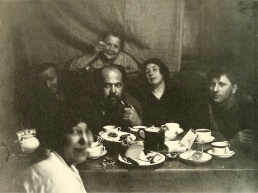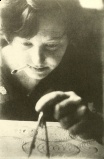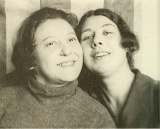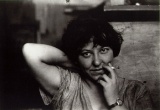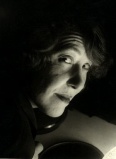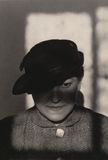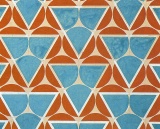Difference between revisions of "Varvara Stepanova"
(→Works) |
|||
| Line 23: | Line 23: | ||
==Works== | ==Works== | ||
<gallery> | <gallery> | ||
| − | + | Stepanova_Varvara_1919_The_proletariat_is_the_creator_of_the_future_not_the_heir_to_the_past.jpg|''The proletariat is the creator of the future, not the heir to the past'', 1919. | |
| − | + | Varvara_Stepanova_Circle_Points_1923.jpg|''Circle Points—Teal and Orange'', 1923, textile pattern for mass production. | |
| − | + | Varvara_Stepanova_textile_pattern_design_for_production_1924.jpg|Textile pattern design for production, 1924. | |
| + | Varvara_Stepanova_textile_design_1924.jpg|Textile design, 1924. | ||
</gallery> | </gallery> | ||
Revision as of 11:33, 1 April 2013
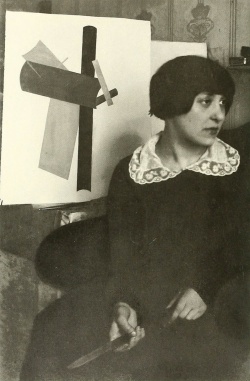 Moscow, 1916 | |
| Born |
November 9, 1894 Kovno (now Kaunas), Russia |
|---|---|
| Died |
May 20, 1958 (aged 63) Moscow, Soviet Union |
Born Varvara Fedorovna Stepanova in 1894 in Kovno (now Kaunas, Lithuania) to the peasant family. 1910-11 (ca) studies at the Kazan School of Art, Odessa, where she meets Rodchenko whom she subsequently marries. 1912 moves to Moscow, attends the Stroganov School (1913-14) and studies under Mikhail Leblan, Konstantin Yuon, and Ilya Mashkov. 1914 gives private art lessons, exhibits at the Moscow Salon. 1915-17 works as an accountant and secretary in a factory. 1916 with Rodchenko leases an appartment owned by Kandinsky. 1917 experiments with non-objective art and begins to create experimental non-objective visual poetry. 1918 produces collaged and handwritten books, including Rtny Khomle, Zigra Ar and her masterpiece Gaust Chaba, in which she wrote her zaum' text on newspaper. 1918 contributes to the First Exhibition of the Young Leftist Federation of the Professional Union of Artists and Painters and the Fifth State Exhibition. After the Revolution she works in the Museums office of the IZO NKP (Visual Arts Section of the People's Commissariat for Enlightenment). 1919 contributes to the Tenth State Exhibition: Non-Objective Creativity and Suprematism. 1919 becomes involved with the Futurist poets, composing zaum' ('transrational') poetry herself; illustrates Alexei Kruchenykh's book Gly-Gly. 1919 begins making works in a style that by 1921 came to be known as Constructivism. 1920-23 participates in discussions and activities of INKhUK, in Moscow, as a member and, in 1920-21, as research secretary. 1921 contributes to the exhibition 5x5=25. 1920-25 teaches at the Krupskaia Academy of Social (Communist) Education. 1922 makes collages for the journal Kino-fot. 1922 designs sets and costumes for Vsevolod Meierkhold's production of The Death of Tarelkin at the Theater of the Revolution. 1922 makes series of linocuts on the subject of Charlie Chaplin. 1922 contributes to Berlin's First Russian Art Exhibition. 1923-28 closely involved with the journals LEF and Novyi Lef. 1923-25, with Lyubov Popova, becomes designer of textiles at the Tsindel (First State Textile Factory) near Moscow. 1924-25 professor of textile design at the Vkhutemas. 1925 contributes to the Exposition Internationale des Arts Décoratifs et Industriels Modernes in Paris. 1926-32 works predominantly as a book and journal designer, fulfilling major government commissions. 1930s-50s continues to paint, design, and exhibit. 1941-42 lives in Perm. 1958 dies in Moscow.
Portraits
Stepanova drawing textile designs, 1924. Photographed by Alexander Rodchenko.
With Lyubov Popova, Moscow, 1924. Photo by Rodchenko.
Works
Literature
- Camilla Gray, The Russian Experiment in Art, 1863-1922, Thames and Hudson, 1986.
- John E. Bowlt, Matthew Drutt (eds.), Exter, Goncharova, Popova, Rozanova, Stepanova, Udaltsova: Amazons of the Avant-Garde, The Solomon R. Guggenheim Museum, New York, 2000.
- Irina Aristarkhova, Stepanova's 'Laboratories', in Place Studies edited by Andreas Broeckmann and Gunalan Nadarajan, 2008, pp 167-182.

